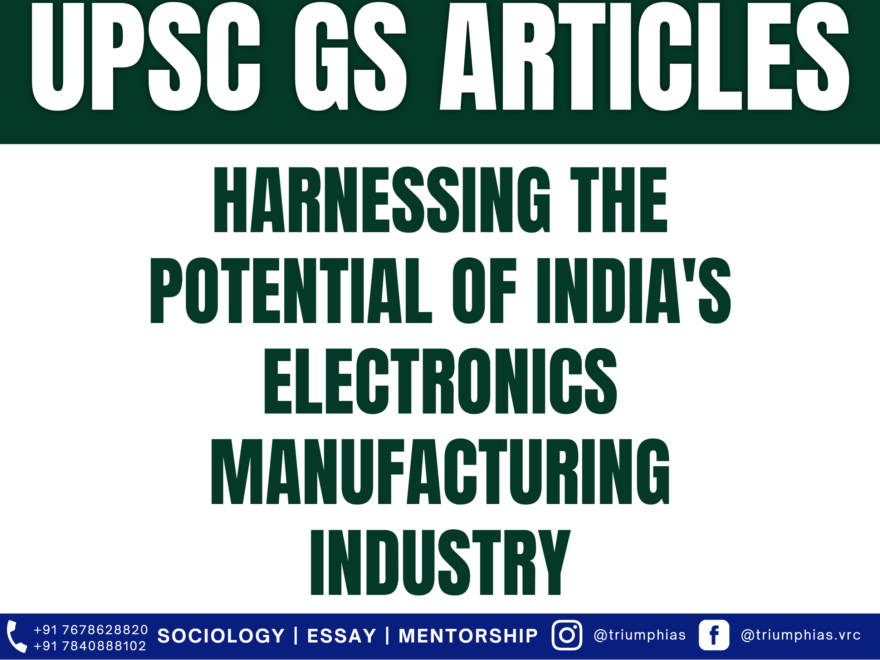Potential of Electronics Manufacturing
(Relevant for General Studies paper Prelims/mains)

India has taken active measures to position itself as one of the most rapidly advancing economies globally. Within this framework, the narrative surrounding electronic manufacturing holds notable importance. Businesses worldwide are increasingly considering India as a prime location for their Electronics Manufacturing operations, aiming to meet the growing domestic demand for electronic goods.
Recognizing the sector’s immense growth potential and its ability to generate significant employment opportunities, the Indian government is wholeheartedly embracing the ‘Make in India’ program as a central policy initiative. This program is designed to bolster and accelerate the country’s manufacturing sector, including the electronics industry.
Current Scenario of Electronics Production in India
The global electronics sector holds the distinction of being the largest category in terms of manufacturing and trade, with a value exceeding USD 2 trillion. Notably, China accounts for more than 50% of this market share.
However, the escalating labor costs in China are prompting buyers to seek diversification and risk reduction in their supply chains. This presents a unique opportunity for India. India emerges as a prominent contender for offering alternative solutions to global electronics companies.
The electronics sector in India possesses the potential to become one of the country’s leading exports within the next 3-5 years. Furthermore, India is projected to achieve the milestone of becoming a USD 1 trillion digital economy by FY26. The electronics manufacturing industry has witnessed substantial growth, rising from USD 37.1 billion in 2015-16 to USD 67.3 billion in 2020-21.
India’s ambitious target is to reach USD 300 billion in domestic production by 2026. To achieve this goal, the Ministry of Electronics and Information Technology (MeitY) has outlined in its Vision Document 2.0 that specific high-potential product segments should be identified and supported through incentives and policy measures. Notably, exports ranging between USD 120-140 billion are crucial for reaching the USD 300 billion mark in Electronics Manufacturing.
Challenges in Making India an Electronics Hub
- To encourage local manufacturing, countries often resort to imposing high import duties and stringent localisation norms.
- While these measures do contribute to boosting domestic production, they can also have adverse effects on a country’s global competitiveness. This is particularly evident in the electronics industry, where supply chains are intricately intertwined on a global scale.
- Compared to India, countries like Vietnam and China offer more favorable subsidy structures, especially concerning machinery used in manufacturing and research and development. Another hurdle is India’s limited ecosystem of companies engaged in local component manufacturing for electronic products.
- Due to the absence of a comprehensive component ecosystem, these components need to be imported, resulting in increased costs and longer lead times for manufacturers. Presently, there seems to be a lack of active policy support that promotes local manufacturing, including support for domestic players.
- The regulatory framework and bureaucratic procedures in India can be complex and time-consuming, further hindering the ease of doing business.
- Streamlining regulations and reducing bureaucratic red tape would not only improve the business environment but also attract investments and create a conducive atmosphere for electronics manufacturing.
- Moreover, electronics manufacturing often leads to the generation of electronic waste, which poses significant environmental challenges. Without effective implementation of sustainable practices such as e-waste management and the promotion of environmentally friendly manufacturing processes, the environmental impact can outweigh the intended benefits.
Steps Taken to Improve India’s Electronics Sector
- The growth of electronics manufacturing heavily relies on the presence of large-scale clusters that offer significant economies of scale.
- However, India has not yet developed its manufacturing clusters to the required scale. Currently, India has approximately 400 Special Economic Zones (SEZs) scattered throughout the country, aimed at promoting exports.
- However, when compared to the Shenzen SEZ in China, these SEZs collectively contribute only half the export volume.
- To establish a strong presence in the global electronics market, India must prioritize the creation of mega-scale electronics clusters in strategic locations across the country. Regions such as Uttar Pradesh (Noida), Tamil Nadu, and Telangana have already shown promising growth and should be further supported to develop globally competitive electronics clusters.
- To achieve this, there needs to be a comprehensive reassessment of our approach, particularly in terms of taxation, labor laws, and worker housing.
- These areas require significant reforms to ensure India can effectively compete in the global market.
- India is currently transitioning from being an electronics economy focused on import substitution to becoming an export-driven economy.
- The complex and fluctuating duty structure poses a significant challenge in establishing India as a preferred assembly hub for global Original Equipment Manufacturers (OEMs). Therefore, a thorough review of these structures is necessary to remove barriers and attract more OEMs to invest in India.
It should be recognized that achieving the vision of a ‘Self-Reliant India’ requires significant upscaling of capabilities and technology adoption in various manufacturing sectors. The current priority is to create a conducive environment that encourages innovation, safeguards intellectual property, prioritizes skill development, and establishes infrastructure that supports the overall ecosystem.
To master these intricacies and fare well in the Sociology Optional Syllabus, aspiring sociologists might benefit from guidance by the Best Sociology Optional Teacher and participation in the Best Sociology Optional Coaching. These avenues provide comprehensive assistance, ensuring a solid understanding of sociology’s diverse methodologies and techniques.
Electronics Manufacturing, Make in India, Indian Economy, Manufacturing Industry, Electronics Industry in India, Trade and Manufacturing, Domestic Production, Global Market, Export-Driven Economy, Ministry of Electronics and Information Technology, Digital Economy, Best Sociology Optional Teacher, Best Sociology Optional Coaching, Sociology Optional Syllabus.
Follow us :
🔎 https://www.instagram.com/triumphias
🔎https://www.youtube.com/c/TriumphIAS
https://t.me/VikashRanjanSociology
Find More Blogs
|
Scope of the subject and comparison with other social sciences |
|||
|
|
|
|
Modernity and social changes in Europe |

